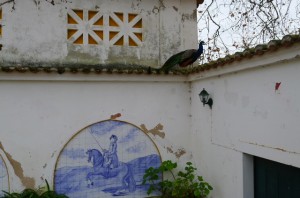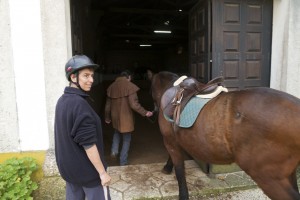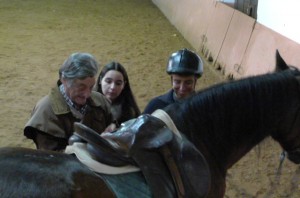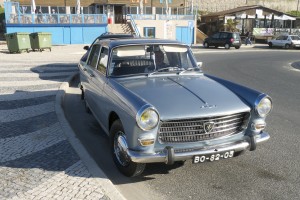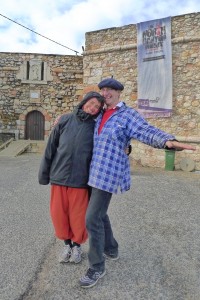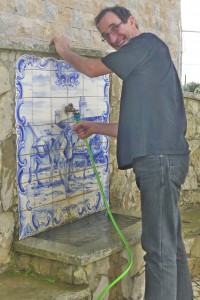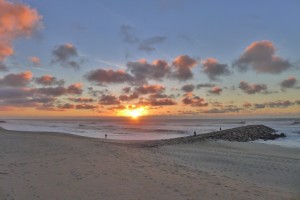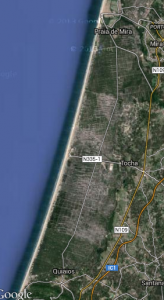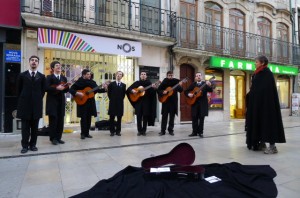Foz do Arelho
The Lagoa do Òbidos has the reputation of being the most tranquil and beautiful Lagoon in Europe. So if you are anywhere near this area, don’t miss out on spending a night or two here, and make sure you get a chance to see the sunrise or sunset, because they are spectacular. Emma is parked up in the local camper-stop which is right by the lagoon, so each morning we are woken by the cockle pickers arriving and getting into their waders. They go out for several hours, up to their waists in water. One morning, Hernani gives us a bagful of freshly caught cockles and Sandra tells us how to cook them – no water or salt, just fry some onion and garlic, add the cockles and when they are all open, add lemon juice and fresh coriander. The cockles hold their own seawater, which mixes with the lemon juice to make a very fine tasting sauce. We’ve never eaten such delicious cockles!
We were told the lagoon had flamingos – sadly we didn’t see them…
On Christmas Eve, we joined the locals for a midnight bonfire on the central square, chatting with Sandra about her hopes and aspirations for this village. Having spent all her childhood holidays here with her grandparents, she has finally fulfilled her dream and moved from Lisboa to Foz where she found work with the local council, looking after the camp site and organizing events to benefit the community. She carries a lot of passion for this village and does not want it to go down the route of Òbidos (see our previous post on this), but instead be a clean and thriving place for the locals as well as for the kind of visitors who like the simple, natural beauties of the lagoon and the sea.
On the square right next to where the fire was, is a band-stand. Frank and I use it for a little practice. While we are up there, we are high enough to look over the wall across the road. We see a very impressive looking building in a well-kept garden, old splendour on a grand scale. There are some people in the Garden, and as the gate is open and Frank is ever curious, we go in and strike up a conversation with the owners.
Francisco the younger one (there are many Franciscos in this Family – every first born male is called Francisco) tells us that the house is 500 years old and has been the seat of his family for all that time. They are Counts, and a very large area of land belonged to the property until the revolution in the mid seventies, when land was taken off the noble classes and reapportioned to the poorer people. So in the lifetime of Francisco (the older one), the property has shrunk from 4000 hectares, to a few fields around his house. We are shown the inside of the house too – the whole of upstairs breathes the history of Francisco’s family. We walk through beautiful rooms with a view onto the lagoon, decked with furniture from across the centuries, filled with items, pictures and busts that speak of previous generations. Francisco (the older one) is the guardian of all these treasures. The expansive grandeur of previous ages has been shrunk and condensed into these few rooms that he inhabits as well as takes care of. This man has seen a lot of changes in his life, and the discussion over land is still on-going, with the village wanting to obtain more property from the family. I guess it’s not easy to assess fairly the point at which someone has come to the limit of their resources, when what is visible looks so grand. I remember this feeling from growing up in a Doctor’s household: people make assumptions about a family’s wealth according to their status in society, and it’s not always accurate. There is a quiet humility, paired with a gentle light in Francisco’s eyes that remind me a lot of my father.
The whole of downstairs has been done up to accommodate visitors. It is beautifully done. A large reception area with a vaulted ceiling has comfortable seats and sofas and a few tables to play games at. Leading off this long room are a number of large bedrooms which overlook the courtyard where peacocks peck the Earth under some very old plane trees. It is a great place to come and stay in Foz!
In the forecourt, I pick up the smell of horses, and yes, they have horses and a stable where they give riding lessons. Francisco (the older one) is a very experienced rider and trains horses in the Viennese-Spanish school of dressage. He learnt from his grandfather (who no doubt was a Francisco too). Unfortunately he is suffering from very painful hips, which has prevented him from riding for 6 months – or possibly fortunately for us, because Frank offers him a massage, which he gratefully accepts. The next day, he feels a lot better and we propose a riding lesson in exchange.
The horses are big and beautiful. I am allowed on Pharao, the ‘child’s horse’, the one for beginners. The other ones are very sensitive and if you can’t handle them right, you’re in trouble. I’m glad I’m on the beginner’s horse – even that one is much more sensitive than any horse I’ve ever ridden! The tiniest movement is a signal for him to go, stop, turn etc etc. Absolutely no pulling on the reins, that’s far too strong. Even when I think I’m not pulling, my signal is far too big. Often Pharao starts walking backwards when I only wanted him to stop.
I work very hard, Francisco is happy with my progress, and when I ask to stop, he still has more to teach me. I have to come back next day and the day after, to learn more. What a treat to be taught by such a master! Thank you, Francisco for your generous sharing! We are so pleased that Frank has been able to remedy your painful hip with his massage. Especially as it means we get a chance to see you in your element the next day, on the horse, showing us how it’s done properly! Except, we can’t see how it’s done – Francisco sits on the horse as if in a trance, one doesn’t see any movement of his hands or legs, and yet the horse performs all these very precise actions, like a dancer stepping to the beat of Fado, traversing the hall lightly trotting, with feet crossing over as in Tango. His connection with the horse verges on telepathic!
In fact, the subtlety of riding a horse in this way reminds me a lot of Tango. So after my last lesson, we give a little dance demo to Francisco, a small gesture of thanks for the hours of fantastic tuition. We leave Foz do Arelho feeling greatly enriched by the experiences we had here and the connections we made with the people.
******
To see more pictures of the beautiful Quinta da Foz, Francisco’s home and a great place to stay, click here
We will add a contact for the camper stop by the lagoon later.
Posted in Uncategorizedwith 2 comments.
Christmas Greetings
For those who prefer to look at photos rather than read, enjoy some new photos of a stunning sunrise on flickr, and with it we send you our love and Christmas greetings!
*******
For those who have time for stories, please read on…
Christmas, stripped of its routines, away from family and instead parked up by a lagoon outside a little village that hardly bears any signs of the festive season. It invites me to rethink about what is important to me and in my life.
In my childhood, Christmas was always a time of stories. My mother would read a story to us by candlelight, surrounded by the smells of my grandma’s freshly baked biscuits.
One that sticks in my mind and often comes back to me, was Tolstoy’s Wieviel Erde braucht der Mensch?(How much land does a man need?) For those who don’t know it, here it is online. I know, it’s not your run of the mill Christmas story, but then my mother was not a run of the mill woman 😉
Recently we have met people who, for one reason or another, made me think of that story again.
There’s the retired couple, let’s call them Bob and Ann, who moved from England to settle in Portugal’s interior. They arrived in a campervan, even bigger than our Emma, fell in love with the area and stayed. They built their house in a little village surrounded by olive groves. Bob is a very smart man, and it is obvious that in his working life he earned enough money so as not to have any financial worries now. The house is quite unusual, not the kind of house I would build, but it seems exactly how they want it, and they both seem happy with it and each other.
Their campervan now sits in the driveway, a grand home for their cat! Bob collects instruments, and from his stories we gather that he once picked up a very valuable violin in a job-lot. Were he to sell it, it would fetch a lot of money but Bob says, Why sell it? I have enough, I’ve got everything I want.
It is so rare to hear someone say that. Who knows when they have enough, and what is enough to you? What is enough to me? What do I really need?
Rich people often suffer from wanting more. Bob is an exception, I think. In addition to having enough material goods, he has a sharp mind, a great sense of humour and an open heart. He looks out for those who may need help around him and he will always help if he can.
****
In Òbidos, the Christmas brimborium is in full flow. This is one of the most touristic towns we have passed through in Portugal, and yet, the fabric of the town seems neglected, it seems everyone is after the money from strangers to line their own pockets, nothing gets ploughed back into the place. The town looks tired. What a contrast to the social entrepreneurship that was at the heart of the development in Cháos!
We weave through the less populated part of the town when we come across a short scene of love and separation: a woman is waving a man good-bye, on Christmas eve. There is obviously a strong bond of love between them and the parting is not easy. She remains behind, clutching a young Siamese cat while he drives off.
****
Down by the seafront in Foz do Arelho, we meet a man in a Peugeot 404, built in 1967.
Frank loves this car, his father also had one, but the 6-seater version. We start talking to the man and it turns out that he bought it new when his daughter was a toddler, over 45 years ago. Everything is still original, the leather seating, the paintwork, everything. Every weekend, he drives the 80km from where he lives to bathe his ailing legs in the seawater. This is a ritual trip down memory lane – he says he’s got the spirits of his parents sitting on the backseat and his wife sat next to him. The car is family he says, and it brings him close to those he has lost. He sits in his car, happily eating persimmon fruits that he picked from his tree, enough to feed his whole family of spirits. There is such a bittersweet feeling about him.
I feel so blessed to be where I am and with the man I love. It feels such a great gift to have found each other, to feel love with no hesitation, no ifs and buts: to experience people and nature together and to have time and space to dance, to read, to reflect; to connect to each other’s families and to share the joys and worries for our respective offspring. I feel a great peace inside me. Of course, I love Totnes, my flat in Seymour Villas and most of all the people in the house and Frank loves his house and garden in Cardiff but it seems that for us, peace doesn’t lie in a physical place but in the heart of the relationship, never mind where we are.
It is from within this peace, that we want to connect to the outside world, to our children and wider families, to the communities we live in and so wish to send you all a part of this feeling. Have a Happy Christmas and festive season wherever you may be!
Ruth & Frank
Posted in Uncategorizedwith 3 comments.
Sunrise, Sunset – a Day by the Lagoa do Òbidos
Happy winter solstice to all!
There are not many words that can describe experiencing the light in this place –
You can get a taste of it on our flickr album.
Love, Ruth & Frank
Posted in Uncategorizedwith 1 comment.
Surfers at Nazaré
This was what we missed in Nazaré, we were a few days late… Never mind, the beach was beautiful without surfers.
http://www.networka.com/big-thursday-nazare-december-2014-big-wave-session
Posted in Uncategorizedwith comments disabled.
Nazaré
This is a lovely seaside fishing town. We had hoped to see the great waves and some reckless surfing but by the time we arrive, the sea is flat as a pond. Well the waves are ‘only’ about 3 mtrs high. In the first photo on the Flickr album to go with this chapter, you’ll see Frank walking off his frustration, collecting firewood.
We spent a few days here. The local mayor was kind enough to arrange a practice space for us in the sports centre, so we’ve been dancing an hour or so every day and made use of the hot showers 
Praia do Norte is a beach just outside Nazaré. I have fallen in love with this beach. I don’t know what it is, but something feels just right about being there, in the wind, falling asleep and waking up to the sound of the pounding waves…
The photos will mainly be about two things: the beach and the extravagant dress code of the local women. Enjoy them on Flickr. By the way, did you know that you can view photos as a slide show on flickr? I’ve only just discovered the button myself: It’s the third symbol in on the right hand side on the top. It’s worth it this time, there are some amazing faces in this town, and the sunsets are spectacular.
Posted in Uncategorizedwith comments disabled.
Cháos
Portugal is treating us kindly. Beautiful smells in the hills lead us to wild thyme and rosemary. The villages have pumps with fresh water.
Oranges abound – we find trees in public spaces or outside abandoned houses and help ourselves to fallen fruit. We roast orange peel and eucalyptus leaves on top of the wood burner and enjoy the beautiful smells permeating our ‘house’. 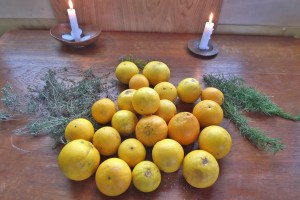
Strong winds against the side of the van rock us to sleep, the rain washes the dirt off Emma at night and the sun loads up our solar lights by day. We wake up to beautiful seascapes, the water roiling below us, waves vying with each other in their race to reach the shore.
Due to our bad map of Portugal, we find another special place. Once again, we get lost in the middle of nowhere and stop by a farmer’s house and ask for directions. I’m now keen to practice my newly gained Portuguese, so 10 minutes later, we leave not only knowing where we are but with a recommendation to see a village called Cháos (not on our map). Don’t be fooled by the way the name looks, it’s pronounced kshonge, or something like that – not unlike the French word for change and means the ground upon which we stand. We are told they make good local food, so we drive up there to find out.
What we find is a village that, with the driving force of two main protagonists, has created a viable business that benefits many of its inhabitants. There is a cultural centre at the top with a bar and restaurant as well as some accommodation. Good food is served – regional recipes made with their own meat and veg. Next door is a workshop with several looms, where some local produce such as honey and woven artifacts are for sale. Also nearby is a building dedicated to apiculture and we see a herd of freely roaming goats, watched over by a shepherd.
We hear from Ricardo, one of the younger members of the cooperative, that the initiative grew from a group of folk dancers. The idea was to create a number of diverse projects, so that the younger generation would find reasons to stay in the village rather than decamping to the city, as has happened to so many communities in both Portugal and Spain. All projects are created with the aim of being self-supporting. Everything is interlinked and benefits the community as a whole. They also organize international work camps in the summer, where people come and stay for a couple of weeks, indeed some of the buildings were built by international volunteers. Last year’s work camp was dedicated to maintaining the old mountain trails, clearing the paths and repainting the signs so people wouldn’t get lost anymore. Another project is to offer countryside experiences to young people from the cities, involving them in farm activities, such as planting and harvesting potatoes or milking goats.
The community is a pioneer example of social enterprise and they host conferences for people from all over Europe on this subject. Everything new is done with local traditions in mind, so for example they re-introduced the goats that had been roaming these hills for many hundreds of years, their eating habits being tuned to the local vegetation. They help to clear the undergrowth, thus reducing the risk of fire in the summer months, which gains them the nickname ‘firefighters’.
You can contact the cooperative of Cháos by clicking here. It looks like a great place to come for an international work camp!
To see a few more photos, including an ancient dolmen that was incorporated into a church in Alcobertas (near Cháos), click here
Posted in Uncategorizedwith 2 comments.
Serendipity
We returned from our sea adventures to Coimbra in order to practice a bit more Tango on the lovely band stand. After two days though, rain stopped play, so we are moving on Southwards.
On our way out of the city, we stop by a garage to do a bit more maintenance on Emma. It is great how things just seem to fall into place when you are travelling: the garage is run by a Ukranian called Mikhael who waves us in straight away and gets one of his guys, Francisco, to not only grease the nipples but to give Frank one of those roly things that let you go under the vehicle while lying on your back, so he can see where all the nipples are. In addition, Francisco shows us how to jack up Emma with our newly bought 10 ton jack, in case we need to change a flat tyre. This garage has an unusual feel to it somehow. I can’t put my finger on it. Mikhael runs a tight ship. He’s got four or five men working there, and he walks around watching that everything gets done in the way it should, but everyone seems happy, smiley and busy: there’s a good camaraderie in the air. We leave, very thankful for having come upon a garage which would be so generous as to teach us these invaluable lessons.
Our map of Portugal is spectacularly bad, with many roads and villages missing. This results in us ‘losing the way’ (as if we have a way!), and ending up having adventures.
In this fashion, we stop for the night in a place called Fátima, on a very large car park adjoining a church. Judging by the size of the car park, this must be a very touristic spot. It is pouring with rain, so we defer exploring to the next day.
Fátima is in fact a huge religious centre. We have never seen such a big gathering place – it’s 3 or 4 times bigger than the open space in front of the millennium centre in Cardiff. About 100 years ago, this place was an open field where 3 children had a visitation by a lady dressed in white who appeared in a tree and gave them instructions to come back every 13th of the month to see her. She gave teachings to them, which eventually were written down as a series of secrets to do with our time. The basic message was that love is the most important thing and that we are in an age of choice, where we can freely decide between walking the path of love or of hate. Her invitation was to come to her immaculate heart and be protected by her energy.
Initially the children got into trouble for talking about having had a visitation, but other things happened that confirmed their stories, and gradually people started to believe in them. More and more people turned to this place and its benevolent energy. The lady in white was identified as mother Mary and the adoration grew to such dimensions that she was termed the queen of Portugal.
As it happens we are there on the 13th and a friendly woman, who tells us the history of the place, doesn’t think this is by chance but that ‘the lady’ has called us to her….
We walk around for a while. There are many people here, involved in their various forms of devotion. Some pray, while others walk round the building with long candles that they then offer to a large fire (the whole place smells of burning wax). Some are shuffling on their knees all the way across the big square and around the little chapel. This latter devotion is in memory of Lucia, one of the children, who did this once to pray for her mother’s health when she was very ill. Her mother’s recovery led to the villagers finally believing the children’s story.
We have a look at the graves of the three children and discover that two of them, Francisco and Jacinta, died within a few years of the visitation. Lucia lived on until 2005.
We also have a look at the new church at the other end of the square. A huge round building, which looks quite unapproachable from the outside, but inside it has a lovely atmosphere, open and modern, with light streaming in from the ceiling and a big golden mosaic behind the altar. It is huge – it would sit several thousands of people. There is a service going on and then the statue of the lady is led in a procession back to its little chapel. There is an atmosphere of celebration, of joy. It’s more folksy than religious really. It certainly doesn’t have the usual dark and heavy feeling that catholic churches often have.
It is hard to imagine this place like it was when the original story happened – an open field with just a few trees… of course people had to build the structures to cope with the millions of visitors every year (the nearby town of 8000 inhabitants has a bed capacity for 10 000 guests!), but in doing so they build over the very nature of the experience. I wonder what Lucia thought of all the buildings, the huge square, the car parks etc. By all accounts she was a simple, no-nonsense, down to earth woman. I also wonder why the other two children died so young.
After an hour, Frank and I have had enough. The religious flim-flam fills us both with unease, though I have to say the original story touches my heart and whilst it is serendipitous that we’re there on the 13th of the month, somehow this doesn’t surprise me, it just feels right.
And where did the name Fátima come from? This long predates the religious story. When the Moors were in Portugal, one of the Portuguese princes fell in love with a beautiful girl called Fátima. Love transgresses all boundaries, even those of faith. But the real world caught up with them and Fátima had to convert to Christianity so they could be together. His response to her conversion was to call this place after her, in remembrance of their love.
You can see a few photos of Fátima on our flickr page
Posted in Uncategorizedwith 1 comment.
Sand Dunes and Beach
View more photos of the beach on flickr
Sand dunes and beach
I’ve been longing for sand dunes and beaches, so we take a few days to explore the area north west of Coimbra. We’ve been told there are miles of beach along the coast there…
Indeed, there is sand, wind and waves as far as the eye can see. We stay a couple of nights at various beaches, watch beautiful sunsets and have bracing dips in the sea. It is too wild to go in more than knee-deep. Strong currents pile the sand up in irregular heaps, and breaking waves further out indicate sand banks along the shore. Waves are breaking against each other, and there is a strong pull out into the sea once the waves recede. Having spent all my childhood holidays by a sandy shore in Spiekeroog, on the north coast of Germany and watched people drown almost every year, I have a healthy respect for the power of the sea and make sure that we are safe. It all looks harmless enough, but I know very well that if you go in a few feet deeper, you can easily get knocked over by a wave and pulled out and that’s it – by the time help has been called it’s usually too late.
One night we stay in a forested part of the dunes in the middle of nowhere, on a road parallel to the sea. I’d love to get lost in the sand dunes for an hour or so before we leave I say to Frank the next morning. So we set off. Mushrooms everywhere!!! If only we knew better which ones are edible. We err on the side of caution and leave them all behind. We come across an elderly couple who are ‘hunting’ mushrooms with special implements to dig them up. They are after the kind that only just pop their heads out of the sand, their fleshy stalks remaining hidden. One has to be eagle-eyed to find them!
Then we hear the sea, just behind the next few dunes – or so we think. After one hour of fruitless hunting for the sea, scrambling up sandy dunes and down through very overgrown forests, we come upon a huge sandy track, straight for miles, at the end of which we can just about make out the sea. So we decide to give up and go back home along the track, using the position of the sun as our guide. After about 40 minutes of walking along the track in the heat (and no, we didn’t even have water with us!), we come back out on the road, not too far from where we had parked. Phew! One should always be careful what one wishes for – and be precise! ‘an hour or so’ had turned into a good 2.5hrs.
Later that day, looking at googlemaps satellite pictures, we see that we had only made it halfway through the dunes towards the sea. Lucky we turned around when we did. But isn’t this impressive: this is a place in Europe where there is 40km of beach, in two uninhabited sections of 20km each, and you need to walk through about 8km of forested sand dunes to get there in the first place! I feel like packing a day bag and going there, but Frank has had enough of traipsing through deep sand and undergrowth for hours on end…
Posted in Uncategorizedwith comments disabled.
Musical interludes in Coimbra
We find two locations that offer Fado every night of the week – very evocative, sweet and melancholic songs, with two guitars playing accompanying arpeggios that leisurely tumble down, like the worn stairways and cobblestone alleyways of the city. Unlike in Lisbon, the Fado of Coimbra is only sung by men, by students and former students of the city’s university – mainly to serenade the lady there are courting, or to describe their student life.
On Saturday, we pass by a group of students on the main street, and they catch me to be the lady they sing to – one of the students wraps his cloak around me and they place me right in front of the group.
It is a strange feeling, standing there and being sung to by six men… next I get swept away by one of them in a happy dance. When we talk to them afterwards, we find out that none of them are music students. There is a biochemist, a few economy students and a mathematician.
The city is revving up to Christmas – there are groups of folk singers everywhere, in traditional costumes. They don’t really seem to care about an audience, they just sing to each other; maybe it is a contest of songs & singers from different regions.
There are a couple of free concerts advertised. The first one we go to is a Tango concert organized by the psychiatrists of the university hospital. They are lovers of Tango; one of them has been instrumental in bringing Tango to Portugal, another is a Tango composer. All performers seem to be amateurs, including the dancers who perform on a few of the pieces. The whole evening is a mixture of the bizarre and outrageous, some good, some bad but always a surprise. I take my hat off to all of them for having the courage to put something like this on stage.
I don’t know much about the organization that puts on these events, but it has something to do with raising the cultural level of Coimbra’s nightlife, to counterbalance the drugs and violence present in the city. Judging by the smart attire of the audience, I’m not sure though how the concert benefits the subjects of their philanthropy. Well, it’s keeping us off the streets anyway 
The second evening is a concert in the main church in town, where we hear a professional orchestra playing an interesting selection of classical works. The conductor tickles the best out of the musicians. A very sweet trumpet player plays Hummel’s trumpet concerto, framed by a couple of Mozart pieces, one of them with a solo quartet backed by the orchestra, some C.P.E. Bach and to finish off, they are joined by a children’s choir who sing Jingle Bells – a cunning ploy to ensure a full house!
We strike up an interesting conversation with the conductor David Wyn Lloyd, who invites us to another concert and meal a few days later.
This one is aimed at gathering the philanthropists of Coimbra to hear about the various projects afoot in the city to combat violence against women. We recognize many of the people – they came to one or both of last week’s concerts.
The date for the event is the anniversary of the human rights declaration. The long line of speakers bring home the fact that there is still a long way to go to until women in this world enjoy even just basic human rights, let alone equality. The statistics for Portugal are brought home in an art exhibition in the entrance hall: 32 women who have died as a result of domestic violence this year alone in Portugal, and they are represented by little coffins bearing their names and a white flower.
There are about 100 people in the room, many of whom look very well-heeled. The presentations go on for a full 3 hours but hardly anyone leaves. There seems a real desire to tackle violence in this city. Frank and I listen very hard, trying to understand the gist of everything but only managing to grasp a few words here and there. . it is more like a 3hour Portuguese comprehension test but fascinating nonetheless.
A presentation of interactive theatre wakes everyone up: a short role-play of an unequal relationship is followed by an opportunity to put questions to the actors who remain in character throughout. Time is short, so the presentation doesn’t go into creating solutions and replaying the scene with a better outcome, but I think that is what would have followed. Last but not least, two artists and a composer receive a prize for work they have produced this year in relation to combating violence. David and his wife Marina, herself a professional pianist as well as a composer (it was her who won the composer’s prize), play three pieces of music. The acoustics in the hall are unforgiving, and the attention of the audience is low after 3 hours of talks but the music is beautiful and wins everyone over. Rachmaninov, Bach and Elgar on piano and violin. We all leave on a high, if slightly frozen from three hours of sitting in this cold draughty hall.
For those of you who understand Portuguese, you can find the organization who put up most of these concerts on facebook
Some photos of our Fado experience are here on flickr
David, Marina and the classical orchestra of Coimbra can be contacted via their web site
Posted in Uncategorizedwith comments disabled.
Buçaco
More lovely photos of our walk through this park on flickr!
This is a large park maintained by volunteers. A strange, slightly manically decorated neo-gothic castle is surrounded by ancient woodlands with huge trees. The valley has a criss-cross pattern of paths, and stairways that have water flowing down the middle. On the southern side there are some stunning viewpoints. We have a nice chat with a young couple who recommend we go to Aveiro next, even if this means going slightly north.
Posted in Uncategorizedwith 1 comment.
